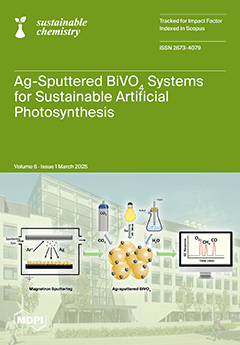The incorporation of Ag nanoparticles onto BiVO
4 (a known H
2O oxidising photocatalyst) through magnetron sputtering to form a composite was studied. ICP-OES results showed that the loading of Ag on BiVO
4 was below 1% in all cases. UV-Vis DRS
[...] Read more.
The incorporation of Ag nanoparticles onto BiVO
4 (a known H
2O oxidising photocatalyst) through magnetron sputtering to form a composite was studied. ICP-OES results showed that the loading of Ag on BiVO
4 was below 1% in all cases. UV-Vis DRS and CO
2-TPD analyses demonstrated that upon incorporation of Ag onto BiVO
4, an increase in the extent of visible light absorption and CO
2 adsorption was seen. TEM imaging showed the presence of Ag particles on the surface of larger BiVO
4 particles, while XRD analysis provided evidence for some doping of Ag into BiVO
4 lattices. The effect of the composite formation on the activity of the materials in the artificial photosynthesis reaction was significant. BiVO
4 alone produces negligible amounts of gaseous products. However, the Ag-sputtered composites produce both CO and CH
4, with a higher loading of Ag leading to higher levels of product formation. This reactivity is ascribed to the generation of a heterojunction in the composite material. It is suggested that the generation of holes in BiVO
4 following photon absorption is used to provide protons (from H
2O oxidation), and the decay of an SPR response on the Ag NPs provides hot electrons, which together with the protons reduce CO
2 to produce CH
4, CO, and adsorbed hydrocarbonaceous species.
Full article





